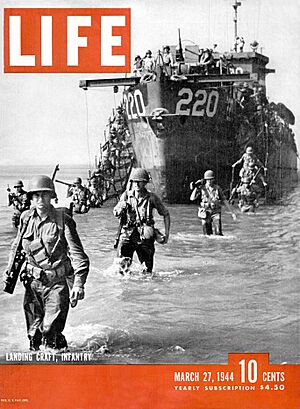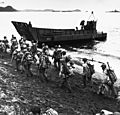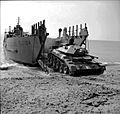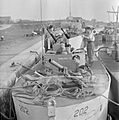Landing craft facts for kids
Landing craft are special boats used by the military. They help soldiers, vehicles, and supplies get from large ships to the shore. Imagine a big ship that can't get close to the beach; that's where landing craft come in! They are designed to deliver everything needed for an invasion or a supply mission right onto the sand.
These boats are unique because they have a flat bottom. This design helps them get very close to the beach without getting stuck. However, this flat shape also means they can be quite bumpy and uncomfortable when the sea is rough. Regular boats that take passengers from big ships to a port are not called landing craft.
What Are Landing Craft?
Landing craft are small to medium-sized boats. Their main job is to move military personnel and equipment. They act as a bridge between large transport ships and the land. This makes them super important for military operations, especially during wars.
Why Are They Special?
The special design of a landing craft allows it to reach shallow waters. They often have a ramp at the front. This ramp can be lowered directly onto the beach. Soldiers and vehicles can then quickly exit the craft. This quick exit is vital during a landing operation.
A Look at Their History
Landing craft have been used for a long time. Even ancient armies used simple boats to land troops. However, modern landing craft really started to develop in the early 20th century. During World War I, there was a need to land soldiers on beaches. The Gallipoli campaign in 1915 showed how important these boats were.
World War II and Beyond
World War II saw huge improvements in landing craft design. Many different types were created for various tasks. These boats were crucial for major invasions. They helped land millions of soldiers and tons of equipment. After the war, landing craft continued to evolve. Today, they are still a key part of many navies around the world.
Different Kinds of Landing Craft
Over time, many types of landing craft were built. Each type was designed for a specific purpose. Some were for troops, others for tanks, and some for supplies. Here are a few famous examples:
Landing Craft, Vehicle, Personnel (LCVP)
The LCVP is often called the "Higgins boat." It was invented by Andrew Higgins. This boat was very important during World War II. It could carry about 36 soldiers or a small vehicle. The LCVP had a ramp at the front. This allowed troops to quickly rush onto the beach. It was a simple but very effective design.
Landing Craft Infantry (LCI)
The LCI was a larger landing craft. It was designed to carry many soldiers. An LCI could hold up to 200 troops. It had ramps on both sides of the bow. These boats were used for longer journeys. They played a big role in invasions like D-Day.
Landing Ship, Tank (LST)
The LST was not just a craft, but a ship! It was much larger than other landing craft. An LST could carry tanks, trucks, and other heavy vehicles. It had a large bow door that opened. A ramp would then extend to the beach. LSTs were vital for moving heavy equipment. They could even cross oceans on their own.
Modern Landing Craft (LCAC)
Today, some landing craft are very advanced. The Landing Craft Air Cushion (LCAC) is one example. This craft floats on a cushion of air. It can travel over water and land. LCACs are very fast and can carry heavy loads. They represent the latest technology in landing craft design.
How Landing Craft Work
Landing craft are built to be tough and practical. Their flat bottom lets them get very close to the shore. This means soldiers don't have to wade through deep water. Many have a front ramp that lowers. This allows for a fast and direct exit. Some even have special guns to protect themselves. They are like floating trucks that can drive onto the beach!
Their Importance in History
Landing craft have changed how wars are fought. They made large-scale amphibious invasions possible. Without them, it would be much harder to land troops and supplies. They helped win many important battles. These boats are a great example of how engineering can solve big problems. They show how important it is to get soldiers and equipment where they need to be, quickly and safely.
Images for kids
-
Anzac Beach amphibious landing, on April 25, 1915.
-
In 1941 a Marine Corps officer showed Higgins a picture of the Imperial Japanese Army practicing landings with the Daihatsu landing craft in 1935, a landing craft with a ramp in the bow, and Higgins was asked to incorporate this design into his Eureka boat. He did so, producing the basic design for the Landing Craft, Vehicle, Personnel (LCVP), often simply called the Higgins boat.
-
USS LCI-326, a Landing Craft Infantry, during training for D-Day.
-
Two examples of the LCM 1 on returning to ships during the 1942 Dieppe Raid
-
A Canadian LST off-loads an M4 Sherman during the Allied invasion of Sicily in 1943.
-
United States Army ships Brandy Station (LCU-2005) and El Caney (LCU-2017) docked in Port Canaveral, Florida.
See also
 In Spanish: Lancha de desembarco para niños
In Spanish: Lancha de desembarco para niños




















